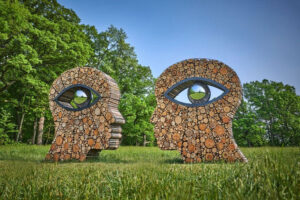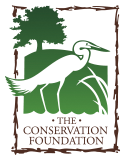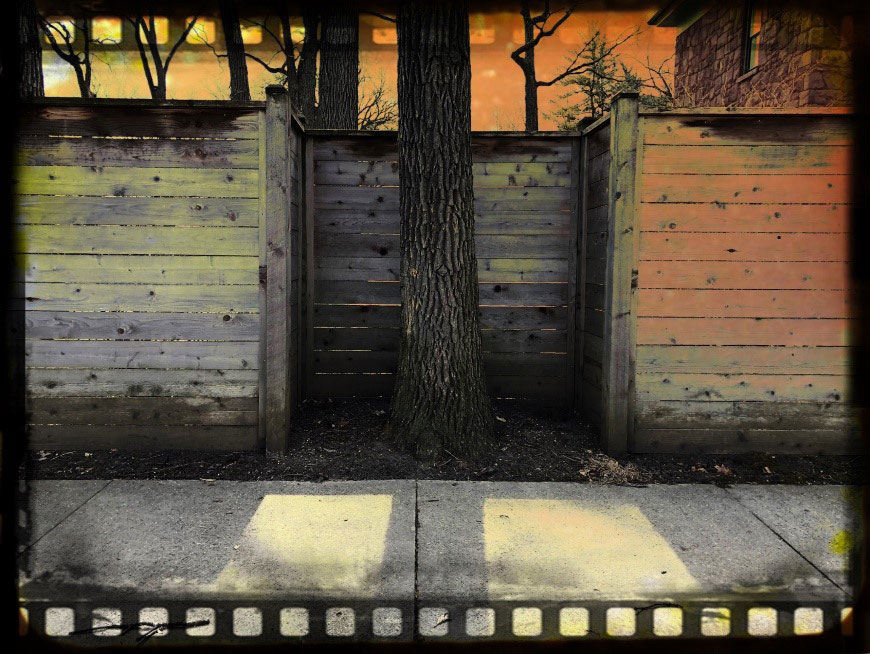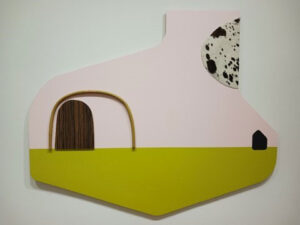Photograph by Nannette Abate, Courtesy of the artist
A preserved tree standing defiantly with a fence forced to go around it symbolizes how art and conservation benefit each other. Conservation preserves nature, which inspires art. Art, in turn, can advocate for conservation.
Nature Inspires Art
Simply put, conservation preserves nature and nature inspires art. This has been true throughout human history. Artists often will take their canvases, paints, and paintbrushes into the great outdoors so they can paint amidst the natural beauty that they wish to depict. Many famous artists specialized in nature paintings, including John James Audubon, Thomas Cole, Claude Monet, and Georgia O’Keefe.
Painting is not the only avenue of artistic expression! All fine arts have been inspired by nature. In music, Beethoven’s Symphony No. 6 (also known as the Pastoral Symphony) was influenced by his great love of nature and his frequent walks in the country. In architecture, Frank Lloyd Wright believed in designing in harmony with humanity and the environment, a philosophy he called organic architecture. He was the pioneer of what came to be called the Prairie School movement of architecture. In poetry, Emily Dickinson often noted the complexity and mystery of nature. In one of her poems, she focuses on the cycles of life expressing awe in the transformation of a caterpillar into a butterfly.

Photo of Emily Dickinson, Credit: Amherst College Library
And regarding sculpture, those who are local to The Conservation Foundation can see the “Of The Earth” show at the Morton Arboretum in Lisle, Illinois. It is a large-scale outdoor art installation that showcases sculptures by Olga Ziemska.

Oculus by Olga Ziemska, Courtesy of Morton Arboretum
Along with inspiration from nature, conservation provides a space to paint, play music, write, or perform whatever artistic expression is desired. This space fosters a “communion” of place and art. Artists say that they can look outside of themselves and let things “flow.”
And aspects of conservation itself can also inspire art. Consider recycling, for example. Today, most people have recycling bins next to their garbage cans. Artists over the years have frequently used found objects and recycled materials for art. For example, there is Marcel Duchamp’s Fountain in 1917 and there is Chicago-based Norman Teague’s Scrap Utopia in 2022 (Norman Teague’s work is being shown at the Elmhurst Art Museum until April 28, 2024).
Scrap Utopia by Norman Teague, 2022, Mixed Media, Courtesy Elmhurst Art Museum
Art Inspires Conservation
The relationship between art and conservation is also mutually beneficial because art can advocate for conservation.
Art Inspires. It brings home images of being together. It inspires people to be part of nature and to protect it. Art can be a catalyst and a convener. Totem poles and outdoor sculpture get people to meet and visit in nature. Art depicts the beauty of nature inspiring its preservation. Art can also depict the degradation and destruction of nature, making the case for these actions to be remedied.
Art is Accessible. Art helps communicate the need for conservation in direct, simple ways. Nannette Abate’s photograph shows the strength of nature and yet its fragility, showing the relationship of protection and conservation.
Art Tells a Story. Art has the power to bring a group together and facilitate a dialogue on conservation. An example can be seen in the May 2021 issue of National Geographic. The cellist Yo-Yo Ma is shown giving a 2019 concert in Jakarta, Indonesia “to help scientists and community members drive home the importance of saving threatened mangrove ecosystems.”
The Conservation Foundation itself has used art to tell the story of the Fox River. Under The Conservation Foundation’s Art of the Fox project, Wheaton artist Joel Sheesley painted the beauty of the Fox River in all its moods and seasons from 2006 — 2019. Sunrise, sunset, in flood, in ice, in summer, in fall, these paintings show you places you know and others you want to find and experience for yourself. Through our partnership with Joel, The Conservation Foundation is working to broaden the interest of local communities in the health of the Fox River.
First exhibited in the fall of 2018 under the name “A Fox River Testimony,” Joel has continued to paint the river he has become deeply connected to, returning again and again to river locations from East/West Dundee to where the Fox empties into the Illinois in Ottawa.

Picture by Joel Sheesley, Courtesy the artist
What we find beautiful, we care for and steward. The Fox River — and the life that depends on it — still needs our care. The Conservation Foundation needs your help as well — not only for the Fox River but throughout northeastern Illinois. Founded in 1972, The Conservation Foundation is one of the region’s oldest and largest not-for-profit land and watershed conservation organizations dedicated to preserving and restoring open space, protecting rivers and watersheds, and promoting stewardship of the environment in the northeastern Illinois suburbs. Join The Conservation Foundation today!
Feel free to comment on this blog and tell us how art has inspired your conservation efforts.
By Steve Stawarz, Oak Brook
DuPage County Advisory Council Member




